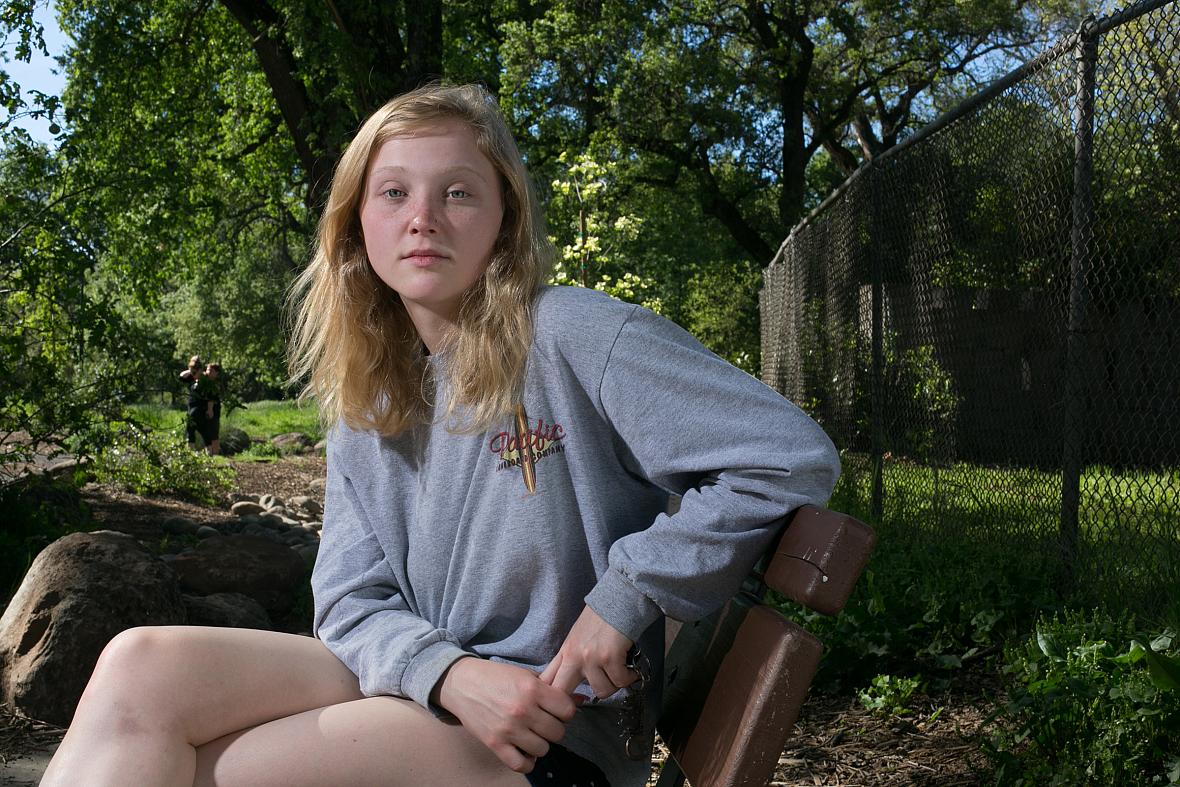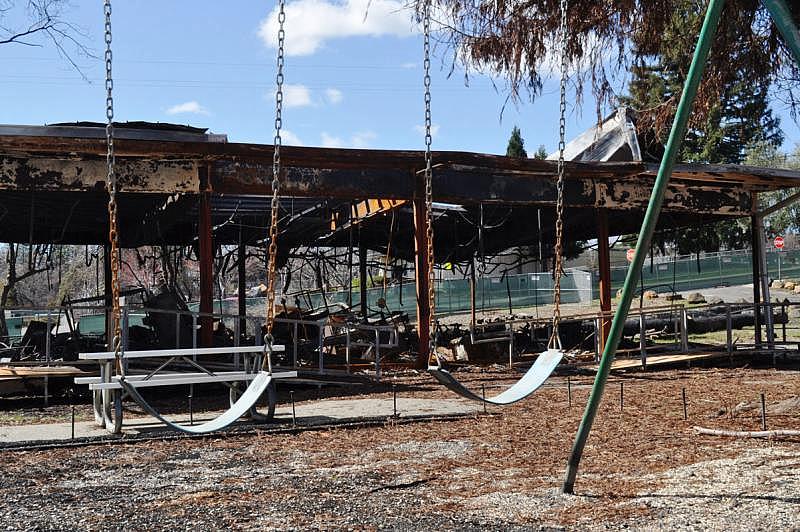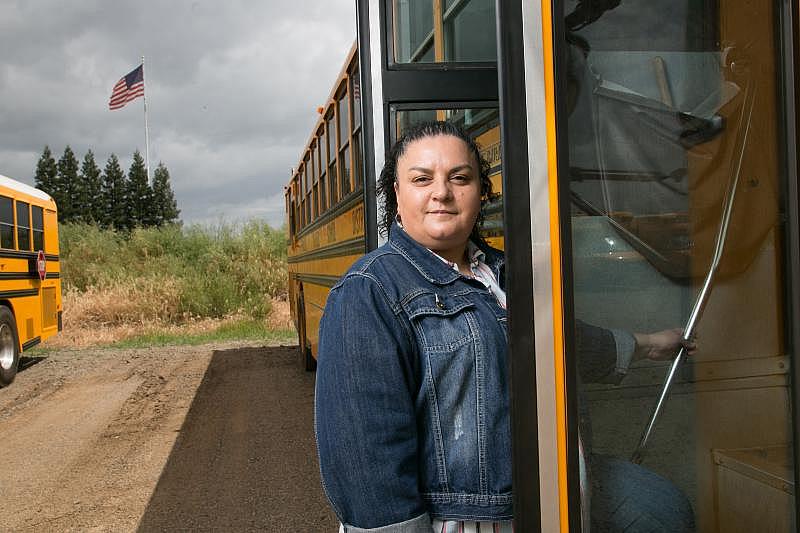Lost Days: Inside one rural California district’s effort to combat chronic absenteeism
This story was produced as part of a larger project led by David Washburn, a participant in the USC Center for Health Journalism's 2018 Data Fellowship.
Other stories in this series include:
Help EdSource shine a light on challenges in rural education
Lost days: Poverty, isolation drive students away from school in California’s rural districts
Rural California school district with high suspension rates under state investigation

Britaney Blair, 18, has been chronically absent for much of her school career. She is from Stirling City, a mountain community.
It’s Dena Kapsalis’ job to fight chronic absenteeism in Paradise Unified, a school district in Northern California’s rural Butte County. And she does whatever it takes.
She’s driven her minivan along the hike-and-bike trail behind Paradise High School in search of homeless students who were known to congregate there.
There was the time a student of hers was going to skip school because he had spent the night at his girlfriend’s house and didn’t have clean clothes. So, she picked him up, drove him to his home in Stirling City — a mountain community in the far reaches of the district — and waited outside while he showered and changed.
“She’s famous for driving up to Stirling City and knocking on doors,” said Melissa Crick, a Paradise Unified School Board member. “She’ll ask them: ‘Why are you not at school today? What do you need? How can I help?’”
These questions are at the core of the mindset change that Kapsalis and others say is needed for educators to have any chance at reducing high rates of chronic absenteeism, which occurs in schools everywhere but is especially prevalent in rural areas.
It means adopting what they call a “trauma-informed approach” to working with students that puts their behavior and performance in the context of their home lives and the trauma they’ve experienced. It is something that Paradise Unified has embraced in recent years.
Among the 98 districts in California with chronic absenteeism rates above 20 percent, which the California Department of Education classifies as “very high,” 84 were in rural areas, an EdSource analysis of state data found. And the 10 districts statewide with the highest rates, ranging from 43 percent to 79 percent, were all rural.
Chronic absenteeism is a significant contributor to poor academic performance, high dropout rates and low levels of college readiness, according to a large body of research. Chronically absent students are also more likely to engage in high-risk student behaviors like drug and alcohol abuse and criminal activity.
Kapsalis is among many educators and youth advocates who say school policies that took a punitive approach to student discipline and truancy exacerbated the problem.
“I really feel that educationally we have blood on our hands as administrators, as educators, from the failed zero-tolerance policies of the past,” Kapsalis said in a recent interview. “There was no accountability for how we gave the impression that [students] weren’t wanted.”
Kapsalis’ official title is director of student services. This means she is in charge of special education and services for homeless and foster youth, suspension and expulsion policy and is the district’s chief attendance officer.
She’s also the principal of Honey Run Academy, Paradise Unified’s community day school for students who’ve been expelled from other district schools or, for other reasons, are habitually absent and failing in the regular school environment.
From these various positions, Kapsalis has led an unofficial cadre of school board members, teachers, nurses, psychologists, bus drivers and nonprofit leaders in Paradise Unified and around Butte County who are working to create school environments that are more welcoming to students and better equipped to address the trauma some of them have experienced.
‘I guess I’m staying home today’
Their aim is to do a better job reaching students like 18-year-old Britaney Blair and her cousins and brothers in Stirling City. Isolated by geography and poverty, getting to school — and then staying there — has always been a struggle for the family.
“If something is bad at home, it’s going to be hard to go to school,” Britaney said in a recent interview. “You can’t even think about that. You can’t think about your stability.”
Britaney’s childhood has been anything but stable. She spent her early years in Stirling City but moved with her younger brother Christian to San Luis Obispo County in 2007 to live with their father. They came back in 2014 when Britaney was in the 7th grade.
In 2015, her mother severely injured her back in a car accident and was mostly bedridden for more than a year. This left Britaney, then in her early teens, with the responsibility for taking care of both her mother and her youngest brother, Kaden.
“I was making food for him and my mom a lot too. That was really hard,” Britaney said. “In the morning, I’d wake up and get him woken up, get him dressed, get him food, get him ready for school. A lot of times I’d get him to the bus but I’d still not be ready.”
On days when she missed the bus, Britaney would run from house to house on her street asking if anyone was headed into town and could give her a ride to school. “If it didn’t work out, I’d just be like alright I guess I’m staying home today,” Britaney said.
Britaney’s troubles at home had a direct impact on her school attendance. She missed 35 days during the 2014-15 school year and 38 days during 2015-16, her attendance records show.
Kapsalis says Britaney’s story shows why it is crucial for educators to get the full picture of why a student is missing school. “We have to understand how kids are being pulled away from school due to issues at home, and also how we are pushing them out,” Kapsalis said.
More accountability
In the 2016-17 school year, after years of lobbying by educators and youth advocates, the California Department of Education began requiring districts to report their rates of chronic absenteeism, which includes excused absences, unexcused absences and missed days due to suspensions.
California classifies any chronic absenteeism rate above 10 percent as “high.” The statewide average was 11 percent in 2017-18, and Paradise Unified’s was 18 percent, according to state data. It is certain to go much higher during the current school year as a result of the Camp Fire, which all but destroyed the town of Paradise last fall.
Paradise Elementary was one of nearly 19,000 structures destroyed in the November 2018 Camp Fire.
Nearly 80 percent of Paradise Unified’s students lost their homes in the fire and enrollment is down by about a third, to under 3,000. The fire struck in the midst of a much larger, slow-motion tragedy that has devastated Butte County and many other rural regions of the state and nation in recent decades.
Among counties, Butte leads the state in reports of what are known as “adverse childhood experiences,” which can include family trauma ranging from neglect and physical and/or sexual abuse to parental drug addiction, incarceration or death.
“It isn’t that the old way of doing things was malicious,” said Matt Reddam, a therapist specializing in childhood trauma who works with schools throughout Butte County. Rural school officials “just weren’t ready for the amount of difficulty that came with methamphetamines, the opiate crisis and everything else…so, schools are now in this confused place. They know they have a problem but they’re still wondering ‘What do we do?’”
Understanding the challenges facing rural districts requires knowledge of their geographies. Paradise Unified is large, more than 70 square miles and spans what locals call the county’s “lower ridge,” which includes the town of Paradise, to the “upper ridge.” The farther up the ridge a community is, the more isolated and poorer it is likely to be.
Stirling City is at the top of the ridge and the last stop on the bus route. Streets with names like “Quartz,” “Diamond” and “Oak” hint at its former glory as a hub of the region’s mining and timber industries through much of the 20th century.
Today, Stirling City is in a state of decay. It no longer has any businesses — not even a corner market — and is home to a diminishing number of working-age people. Of the town’s 201 residents, more than 80 percent are either under 20 or 65 and over, according to the most recent Census estimates.
It’s common for Stirling City kids to end up with Kapsalis at Honey Run Academy. Both Britaney and Christian spent time there. Their cousin, Frankie Bounds, was one of Kapsalis’ more memorable students.
By his own admission, making it to school was not a high priority of Bounds.’ And when he did go, he often ended up in trouble, usually because of marijuana possession, fighting, or both, he said.
“I got suspended and expelled from just about every school up there,” Bounds, now 22, said during a recent phone interview from the Sierra Conservation Center, a prison in Jamestown, Calif., where he is serving an 11-year sentence for attempted murder.
“If I showed up smelling like weed, I would get sent to the office, searched and a lot of times sent home. Sometimes even if I wasn’t smoking, they’d still suspend me,” he said. “The attitude was do things our way or we’re going to suspend you and kick you out.”
But it was clear from his first day at Honey Run in late 2010 that Kapsalis was different.
“I got in trouble with a teacher and sent to the office,” he said. “The principal lady introduced herself. She said, ‘I’m Dena and I know all about you.’ I was ready for her to get on my ass like the others, but she didn’t — this lady was killing me with kindness.”
Britaney has a similar story during that time period. In middle school, she was once suspended for a week after getting into a fight.
“She was instantly right there putting me over her shoulder,” Britaney said of Kapsalis. “The school didn’t try to find out what was wrong but Dena sat down and talked to me about what was really going on…she always reminds me that school matters and this is my way out.”
Spreading a trauma-informed approach
By that time, Kapsalis had already absorbed the concepts of trauma-informed education. And she was not only implementing it at Honey Run, but beginning to spread word throughout the district. She would eventually set up trainings for administrators, teachers, bus drivers and even cafeteria workers.
“We’ve worked on creating a trauma–sensitive food service for kids,” Kapsalis said. “If a kid is acting up in line, we talk about what is the go-to response to that behavior? When was the last time they ate? It might have been the day before at school.”
Ruby Hartwig, the director of transportation for the Paradise Unified School District.
Ruby Hartwig was a Paradise Unified bus driver when Bounds was in school and is now the district’s director of transportation. In recent years, she’s made sure that bus drivers are trained in alternatives to traditional discipline.
“You just have to give them an opportunity to let you know what’s going on in their lives,” Hartwig said. “If they’re having a bad day, there’s a reason…I want them to know that I’m a safe place and my bus is a safe environment.”
Kapsalis has also revamped Paradise Unified’s School Attendance Review Board, commonly known as a SARB. The boards are set up in districts across the state to help address truancy. Historically, they’ve been made up of officials from the district, the county office of education and law enforcement.
Like many others, Kapsalis sees the traditional attendance board approach as intimidating and unwelcoming to families, putting them on the defensive rather than addressing their needs. So she recruited social workers, healthcare professionals and youth advocates to serve on her board.
Among them was Hoppie Campos, a director of the Boys & Girls Club that serves Butte County. Campos said Kapsalis’ innovation was to orient the board to focus on the many needs of each student so it becomes clear to everyone that their poor school attendance is just a byproduct of larger issues.
“Not every kid is going to fit into the traditional way of educating,” Campos said. “What I think makes our SARB board really unique is how we find different ways to reach a kid or find an educational experience that would fit that kid.”
Crick, the Paradise Unified school board member, lived in Stirling City during the 2000s and through the years has been a surrogate mother to Britaney, Frankie and Christian.
She also got involved in the district politically as a parent fighting the closures and consolidations of schools in the district. She’s vocal about her feelings that the problems plaguing rural schools have been largely ignored by officials in Sacramento and believes that more resources need to be directed toward trauma-informed education.
Crick has witnessed the turmoil of Bounds’ life first-hand. She saw him fall apart emotionally and drop out of school after his father, who struggled with drug addiction, was killed during a fight with another Stirling City resident. And she watched his own methamphetamine addiction and criminal behavior, which culminated with him stabbing a man.
Crick in no way feels that the punishments Bounds received at school were directly related to the action that put him in prison. But she does wonder whether he could have been helped by trauma-informed approaches that Kapsalis and others have instilled in the district since he dropped out.
She feels they’ve helped Christian, who is dealing with his own demons and is open about his regular marijuana use.
“I think there has been a real culture change with the way they relate to the students,” Crick said. “They were a lot harder on Frankie, kicking him out if he smelled like he’d been smoking. With Christian, they’re more likely to welcome him as long as he comes to school.”
Britaney, meanwhile, is set to graduate in June and feels like she is on the right track.
“There are a lot of things that go on in our family, but I seem to prevail,” she said. “My thing is to watch and learn and follow the right path until I see otherwise.”
Kapsalis expects to be long retired by the time the change she envisions fully manifests itself. But she plans to keep pushing, especially for students and families to have a bigger say in district policies toward discipline and absenteeism.
“Our next work is to make sure students have a voice,” she said. “And that we reach out to all kinds of different families to bring them together to talk about the future of Paradise.”
[This story was originally published by EdSource.]

